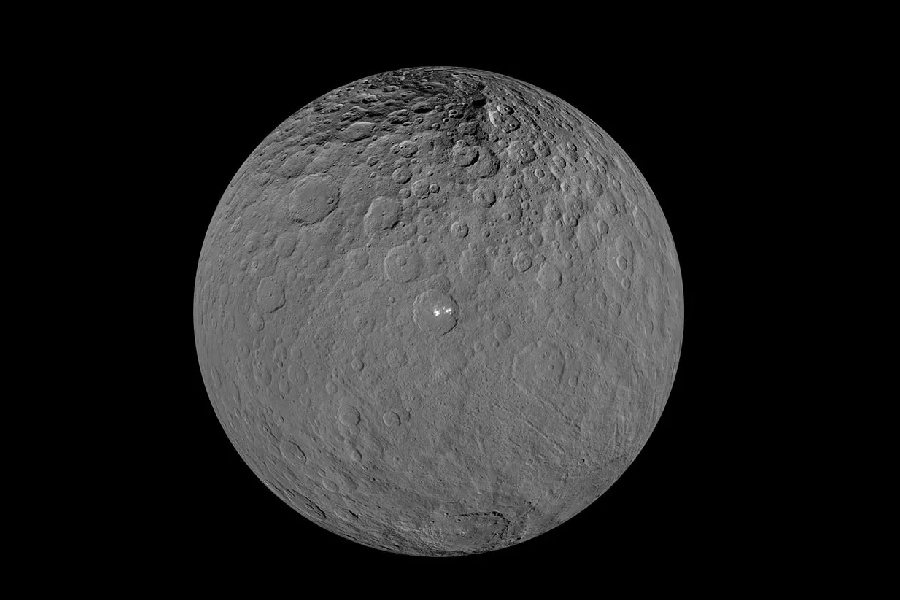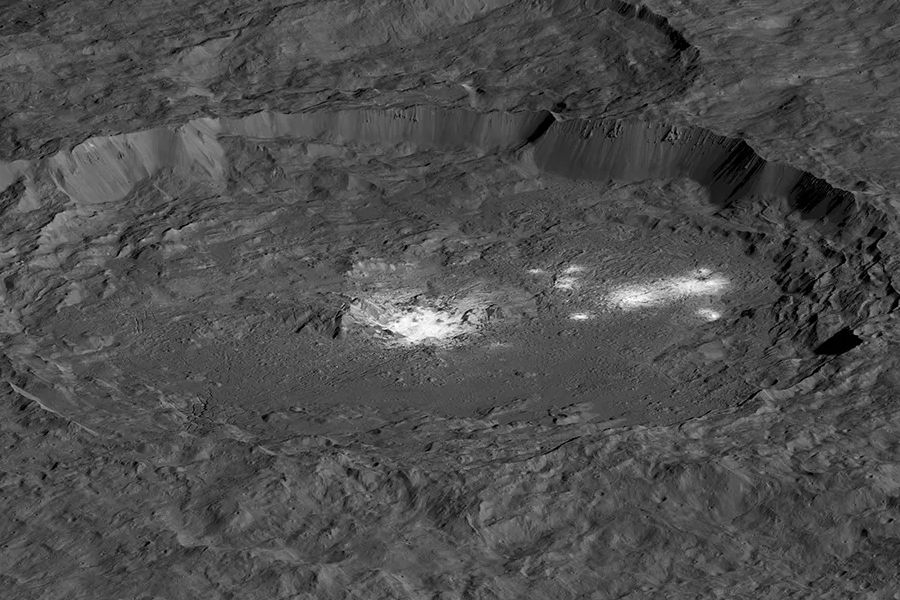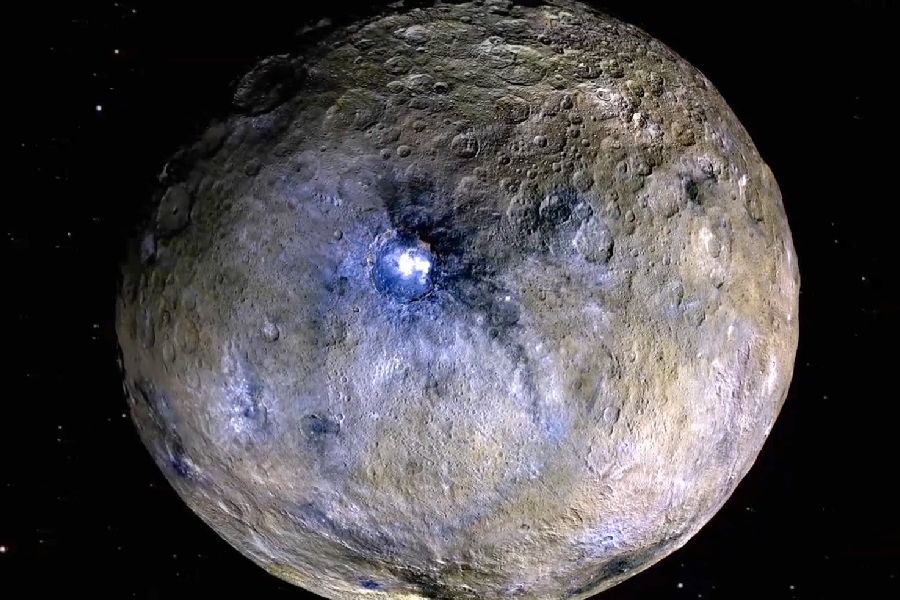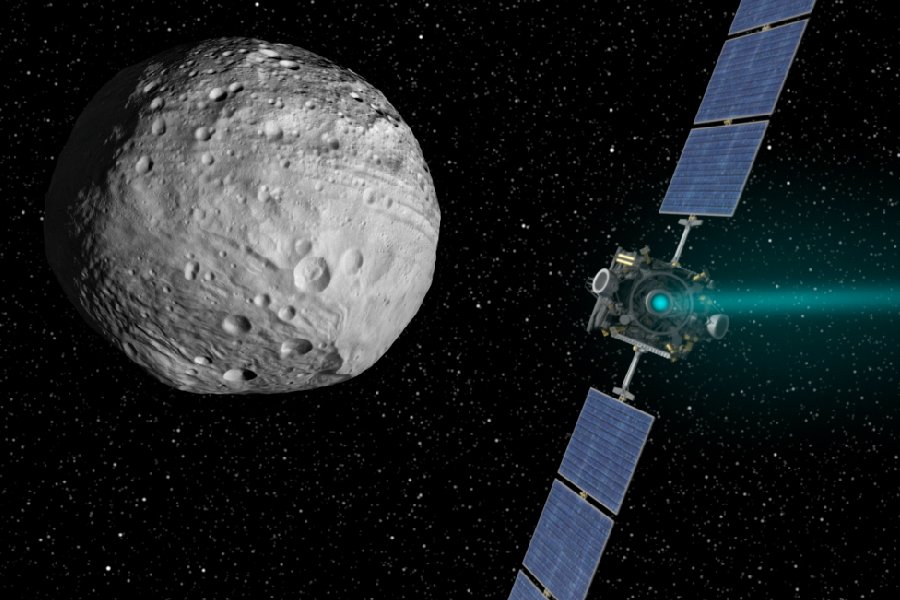One world stands unique among asteroids dwelling in the solar system’s void beyond Mars – Ceres. It is a fascinating world with attributes blurring the distinction between planet and space rock. So, the Ceres characteristics reveal its origins and evolution utterly distinct from dull, inert asteroids.
However, Ceres poses intriguing questions for a modest world. How did it develop possible subsurface oceans and bright mountains, unlike rubble pile asteroids? What led it to acquire a thin atmosphere and other intricate traits, making Ceres seem almost terrestrial? How many moons does Ceres have?
We will explore distinctive geophysics like surface features and composition for clues on internal structure dynamics. By exploring Ceres’ many features, we aim to uncover links between its unique traits and the tangled history that reshaped this frozen world.

Ceres Characteristics
Ceres, the largest object in the Asteroid Belt, is a dwarf planet located between Mars and Jupiter. It has a diameter of about 590 miles and consists of water ice and silicate rock.
Notable features include bright spots in the Occator Crater, believed to be salt deposits, and Ahuna Mons, a cryovolcano suggesting past geological activity. Also, Dawn spacecraft observations revealed water ice on its surface.
Furthermore, orbiting the Sun in the Asteroid Belt, Ceres has a 4.6-year orbital period. Plus, classified as a dwarf planet by the IAU in 2006, Ceres’ characteristics make it a scientific interest and exploration target.
But does Ceres have moons? Ceres, the dwarf planet in the Asteroid Belt between Mars and Jupiter, has no known moons. Observations from the Dawn spacecraft, which orbited Ceres from 2015 to 2018, did not reveal any moons or satellites orbiting the dwarf planet.
Composition secrets
Ceres’ history and constitution are stored in mineral expression, as shown by atomic species identified in reflected sunlight. Iron, magnesium, and nickel compounds point to a primitive chondritic composition similar to carbonaceous asteroids. These compounds formed in the solar system birth near Jupiter before migrating inward.
Moreover, abundant phyllosilicates and smectite clays dominating the surface echo aqueous alteration processes and reactions with liquid water in Ceres’ past. However, the most significant findings are local concentrations of water ice officially confirmed following telltale signatures of energetic particle bombardment.
That is, vast frozen layers likely permeate Ceres kilometers deep in places. These layers are relics of vanished subsurface oceans or accumulated comet impacts importing icy debris.
Ceres Surface Features
Mysteries of Occator Crater
Like a bullseye on an ancient asteroid dartboard, the 60-mile-wide Occator Crater draws eyes for spectacular bright splotches across its floor. These alien salt flats defect attention from darker surroundings aged by eons of small meteor strikes.
But what stories underlie Occator’s flashy deposits almost ten times more reflective than Ceres’ average regolith? Leading theories argue subterranean briny reservoirs occasionally breach the surface as water. This erupted around 20 million years ago when asteroids collided with the Occator.
Hence, impacts likely cracked Ceres’ crust, briefly releasing subterranean stores in cryo geyser-like plumes. Later, they sublimated and distributed salty sodium carbonate residues throughout the crater floor.
Dawn spacecraft’s closer inspection also reveals the center spot, nicknamed Cerealia Facula, hides a pitted dome 2624.67 feet tall – evidence consistent with icy cryovolcanic flows welling upward in Occator’s past. Each bright pixel illuminates geophysical turbulence hinted within.

Ahuna Mons: The cryovolcano that rewrites Ceres’ history
While Dawn gracefully orbited Ceres, an extraordinary feature unfolded on its icy terrain – the striking Ahuna Mons. It is a colossal solitary mountain unlike any other in the solar system, which soars 2.58 miles above the cratered lowlands.
Also, melting ice flows provide a fascinating glimpse of underground activity that might be causing melt generation. Ahuna Mons’ composition shows sodium carbonate and chlorine minerals concentrations, affirming links to briny reservoirs that sporadically breached the surface.
Moreover, cracks likely provided escape routes for buried liquids to erupt, freeze, and stack. Plus, cryo lava accumulated into Ahuna’s lofty height over millions of years in a resurfacing process unlike any asteroid.
This strange pinnacle completely changed geology rules due to the lack of knowledge about cryovolcanic processes on cold, frozen worlds. By probing exceptional landforms at dawn, exciting new chapters on Ceres’ geophysical identity still unfold today.
Water Ice on Ceres
Unveiling water ice exposed on Ceres’ surface
When NASA’s Dawn spacecraft first glimpsed Ceres close-up, scientists received an icy surprise beyond imagining. Unexpected water ice lay splayed raw across the dusty terrain within the 20 million-year-old Occator Crater.
Dawn detected the signature glint of ice crystals exposed by a small recent meteoroid’s high-speed impact blasting the surface. As it got closer, it showed that ice was everywhere, hiding behind the gray dirt covering two-thirds of Ceres’ surface.
What processes raise this precious commodity from the dwarf planet’s dark inner realms? The exploration showcases subsurface models predicting vast icy layers. Beneath Ceres’ surface, even expansive subsurface oceans persist in a liquid state, sustained by mineral radioactivity and insulating layers that trap heat.
However, does Ceres have water? Ceres likely possesses a solid core and a water ice mantle, possibly up to 25% of its composition. If accurate, Ceres contains more water than Earth. So, together with the Jovian satellite Europa and Saturn’s moon Enceladus, Ceres is a tiny world that may harbor a biosphere similar to Earth.
Implications for Ceres’ Composition and Evolution
The exposure of recent water ice marks a pivotal revelation of the true identity of the largest asteroid. Icy geophysical characteristics cement similarities to distant icy moons versus arid asteroids, supporting dwarf planet designation.
Half of Ceres’ total mass may exist as water ice. This forms an enormous, globally distributed cryosphere extending miles down and transforms conceptions of the (once) Asteroid Belt.
Moreover, liquid persistence means Ceres joins an “ocean worlds” club in the solar system. Miles below ice surface barriers, liquid layers are insulated by shared processes for internal heat.
Also, subsurface niches would harbor drastically milder conditions than arid, radiation-drenched surfaces. Perhaps here, amino acids or other prebiotic compounds carry markers of water-rock chemistry in a gentler setting.
Altogether, as a colossal denizen between Mars and Jupiter, the presence of global water ice and its geophysical implications skyrocket Ceres’ astrobiological importance.
Ceres Atmosphere
As the largest object in the Asteroid Belt between Mars and Jupiter, the dwarf planet Ceres possesses a thin, transient atmosphere of water vapor, carbon dioxide, and other volatiles. Being too small to retain thick air gravitationally, the presence and variability of Ceres’ atmosphere intrigues planetary scientists.

Composition and properties
Ceres’ nebulous atmosphere consists predominantly of water vapor with traces of carbon dioxide and likely methane, ammonia, and other volatiles. The air chemistry mirrors surface composition.
The atmospheric pressure, which varies greatly, is between 10 trillionth and 100 billionth of Earth’s. Additionally, radiation quickly disperses short-term air collection while sublimation propels it.
Origin and evolution
Ceres’ atmosphere arises from the sublimation of icy materials unearthed by meteoroid impacts. And exposed subsurface water ice vaporizes upon exposure to space.
As Ceres travels along its orbit, atmospheric density increases, approaching the Sun. It then dissipates, moving farther away, indicating solar warmth’s influence.
Significance in planetary science
Studying transient, vulnerable atmospheres like Ceres helps unveil air retention and loss principles on small icy worlds, with implications across the cosmos. The thin air of the dwarf planet Ceres highlights the fragility of the atmosphere. This contrasts the thick atmosphere of Ganymede, the massive moon of Jupiter, which is gravitationally stable.
Ceres’s Location and Orbit
Ceres orbits the Sun within the Asteroid Belt between Mars and Jupiter amidst rock and metal remnants from solar system formation billions of years ago. The dwarf planet takes 4.6 Earth years to complete one elliptical orbit around the Sun.
Ceres travels through the debris-filled terrain of the Asteroid Belt. Its orbit takes it as close as 2.56 astronomical units at perihelion and as far as 2.98 astronomical units at aphelion. This regular orbital cycle situated Ceres among relic debris dating back to the earliest epochs of the solar system’s history.
Moreover, does Ceres have rings? Well, there is no evidence to suggest that Ceres, the dwarf planet located in the Asteroid Belt, has any rings.
Orbital characteristics
- Elliptical path – Ceres orbits the Sun at an average distance of 2.7 AU on a mildly eccentric route ranging from 2.56 AU at perihelion to 2.98 AU at aphelion. This elongation exposes Ceres to contrasting solar illumination over its orbit.
- Orbital period – Completing its solar circuit once every four years and 219 days, Ceres exhibits contrasts tied to orbital variations. Over this multi-year cycle spanning over an Earth quarter-century, Ceres experiences fluctuations in environmental conditions.
Observations and exploration
Ceres was the first asteroid discovered in 1801. It was later reclassified as a dwarf planet, with mystery surrounding its nature until the Dawn mission unveiled secrets.
NASA’s decade-long Dawn mission orbited Ceres from 2015 to 2018. The mission mapped the geology of the dwarf planet, revealing details about ice, salts, organics, and the atmosphere, which proved revolutionary for understanding this tiny world.

Scientific implications
As a surviving protoplanet embryo from the early solar system over four billion years ago, Ceres offers scientists key evidence for understanding the accretion processes involved in planetary formation. The dwarf planet reveals insights into how the early system coalesced.
Additionally, Ceres has a subsurface ocean that likely contains organic chemistry, pockets of cryovolcanism, and other internal water activity. This makes Ceres a potential candidate for signatures of habitability and prebiotic conditions.
These conditions may have been able to harbor or spawn primitive life forms during the solar system’s history. Thus, the dwarf planet has astrobiological relevance regarding the emergence of life.
Frequently Asked Questions
How is Ceres’ size compared to other celestial bodies in the Asteroid Belt?
At almost 621 miles in diameter, Ceres dominates all other asteroids, comprising over one-third of the Asteroid Belt’s total mass alone. The next largest asteroid, Vesta, spans just over 310 miles, making Ceres nearly twice as wide.
After Vesta, asteroid sizes rapidly diminish to typically only hundreds of meters across. This makes Ceres exceptionally anomalous – a lone giant circulating amidst millions of worlds over ten times smaller on average.
Why does Ceres have no moons?
Despite its relatively large size, Ceres lacks any confirmed moons or satellites orbiting it. The key reason likely lies in collisions and gravity. Models suggest collisions with other asteroids long ago could have destroyed or swept away any then-existing moons.
At the same time, Ceres may not exert enough gravitational pull compared to planets ever to capture orbiting companions. The absence of moons makes Ceres stand out from similar dwarf planets like Pluto, Eris and Haumea, which boast their rich mini-moon systems.
What color is Ceres?
Ceres reflects very little light, making its surface appear dark ashen gray, similar to some forms of carbonaceous chondrite meteorites. Localized variations exist, such as slightly bluer-tinged craters hinting at different compositions below.
Overall, Ceres’ dull gray complexion links to an abundance of dark rock and carbon-bearing compounds mixed across its regolith crust. It absorbs more sunlight than reflects it to our eyes.
What makes Ceres different from other dwarf planets?
Unlike remote fellow dwarf planets orbiting far past Neptune, Ceres resides amidst the rocky Asteroid Belt between Mars and Jupiter. This places it closer to the Sun and terrestrial worlds, resulting in key differences from distant cousins.
For one, Ceres occupies a unique compositional niche. It is neither icy like Pluto nor purely rocky like Vesta. Instead, it is a more evolved mixture of the two, hinting at differentiated layers below. Ceres also bears marks of extensive internal geological activity and alteration, unlike inert asteroids but more muted than icy moons like Europa.
As the only dwarf planet accessible for study not locked beyond the system’s cold outer reaches, these Cerean discrepancies compel rethinking what constitutes a dwarf planet.
What is the temperature of Ceres?
Ceres has a cold and variable temperature due to its location in the asteroid belt. In colder regions, the Ceres temperature can range from about -225 degrees Fahrenheit (-143 degrees Celsius). In warmer areas, temperatures are around -100 degrees Fahrenheit (-73 degrees Celsius).
Conclusion
As we conclude reviewing fundamental Ceres Characteristics, we trace key insights uncovered on the largest asteroid’s origin and evolution. From measuring its anomalous density to mapping its chemistry, we saw how subsurface heating and liquid reservoirs profoundly transformed this frigid world.
Highlighting utterly alien landforms has shown what sets Ceres apart from neighboring asteroids. We hope unraveling geophysical intricacies from Occator’s salts to Ahuna Mons’ cryo-constructed peaks has emphasized Ceres stands alone as a chaperone of our solar system’s early days.
More than a historic leftover, it persists as a living relic bridging the inner solar system’s formative past to astrobiological potentials emerging today on icy orbiters. As Ceres continues guiding our perceptions, may its next revelations affirm that even modest spheres harbor uncharted wonders.
